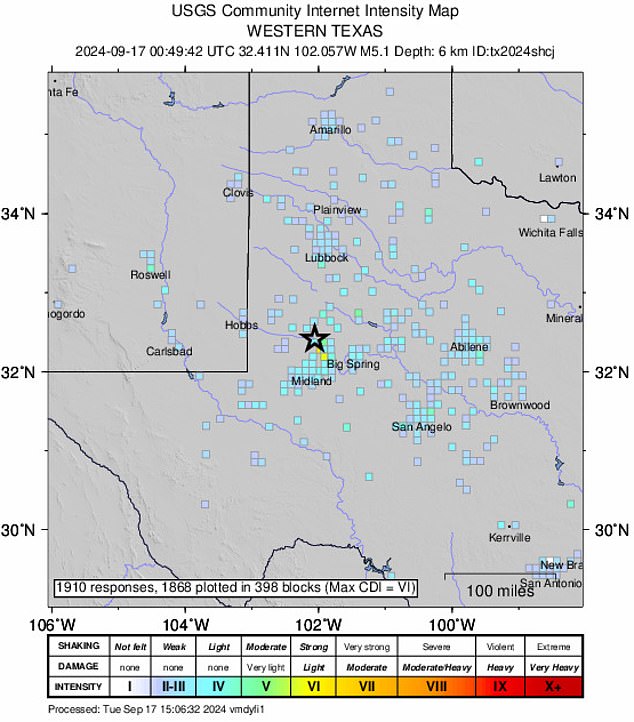Texas hit by one of the strongest earthquakes in state history
Texas was hit by a rare earthquake Monday night that prompted thousands of reports in the western part of the state.
Residents reported their homes shaking for about 10 seconds when the 5.1 magnitude quake struck around 7:50 p.m. local time.
The epicenter was identified in Martin County, near Midland, which is 300 miles from Austin. Residents there also felt a series of shock waves.
According to the U.S. Geological Survey (USGS), Monday’s quake was the seventh-largest in the state’s history. The most powerful quake measured 6 on the Richter scale in 1931.
Residents of West Texas reported tremors Monday night after a magnitude 5.1 earthquake struck the region
According to the USGS, the quake struck about 21 miles (34 kilometers) west-southwest of Ackerly, or 28 miles (45 kilometers) north of Midland, at a depth of about 3 miles (5 kilometers). This suggests that all residents of West Texas felt the ground shake.
Since 1900, more than 3,600 earthquakes have been reported in Texas, with more than 70 of them having a magnitude of 4 or greater and seven having a magnitude of more than 5.
The 1931 event left Valentine terrified, causing buildings to collapse, concrete to crack, and even gravestones in the cemetery to be turned over.
A smaller earthquake measuring 2.9 was also reported in Ackerly around midnight.
According to the USGS, there is a 40 percent chance that an aftershock will be magnitude 3 or greater.
A San Angelo resident posted on X that it was “the worst storm I’ve ever felt.”
Another user pointed out that fracking is the cause of the earthquake.
James Monroe of the University of Texas shared the following on the platform: ‘This earthquake is one of eight earthquakes in Texas history with a magnitude of 5.0 or greater.
“For a state that deals more with oil fields than fault lines, this is a rare event.”
Scientists suspect that the recent series of earthquakes in Texas is largely the result of hydraulic fracturing, also known as fracking, which involves injecting wastewater into the earth to release natural gas for energy.
Fracking is when miners drill deep into the earth’s surface and release water under high pressure. This creates a small explosion, releasing natural gas and oil that can be used to generate energy.

The U.S. Geological Survey website said the epicenter was just north of Midland, but shock waves were felt as far away as Austin, more than 300 miles (480 kilometers) away
Texas is the world’s leading country in fracking. As of February 2017, there were 279,615 oil and gas wells in the state. By 2023, that number had risen to 373,133 active wells.
The action brings groundwater to the surface and when it is injected back into the ground, it puts pressure on the fault lines, resulting in more earthquakes.
“The practice of deep injection of oilfield wastewater, also known as brine dumping, is most closely linked to the increase in earthquake activity and to the largest earthquakes in recent years,” said Peter Hennings, a research professor in the University of Texas Bureau of Economic Geology.
